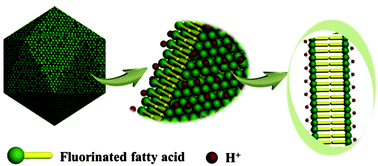Faceted fatty acid vesicles formed from single-tailed perfluorinated surfactants
Abstract
The aggregation behavior and rheological properties of two mixtures of perfluorononanoic acid (PFNA)/NaOH and perfluorodecanoic acid (PFDA)/NaOH were investigated in aqueous solutions. Interestingly, pH-sensitive polyhedral fatty acid vesicles were spontaneously formed in both systems, which were determined by freeze-fracture transmission electron microscopy (FF-TEM) measurements. Especially, a phase transition from faceted vesicles to the L3 phase with the increase of pH was observed in the PFNA/NaOH system while it was not observed in the PFDA/NaOH system. Differential scanning calorimetry (DSC) and wide angle X-ray scattering (WAXS) measurements confirmed that the bilayers of the faceted vesicles were in the crystalline station indicating that the crystallization of fluorocarbon chains was the main driving force for their formation. Besides, the two systems of faceted perfluorofatty acid vesicles exhibit interesting rheological properties, for instance, they showed high viscoelasticity and shear-thinning behaviour, and the elastic modulus (G′) and viscous modulus (G′′) of PFDA/NaOH vesicles were much higher than those of PFNA/NaOH vesicles. Conversely, the solution of the L3 phase with fluid bilayers did not present viscoelastic properties. Therefore, the viscoelastic properties of vesicles resulted from the crystalline fluorinated alkyl chains with high rigidity at room temperature and the dense packing of vesicles. As far as we know, such faceted fatty acid vesicles formed from single-tailed perfluorinated surfactants have been rarely reported. Our work successfully constructs polyhedral fatty acid vesicles and proposes their formation mechanism, which should be a great advance in the fundamental research of fatty acid vesicles.


 Please wait while we load your content...
Please wait while we load your content...